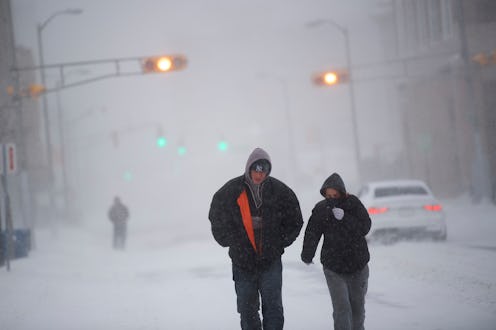Life
How To Prepare For The Nor'easter About To Hit The East Coast

As consistent spring weather continues to elude much of the United States, the east coast is preparing for a nor’easter. The storm is projected to hit early Friday morning around midnight, bringing winds up to 45 miles per hour with heavy rain and snowfall in some areas. Currently expected to extend into Friday evening until 7 p.m., this storm may bring the worst winds in the area since Hurricane Sandy.
For those unfamiliar, the name “nor’easter” is short for “northeaster,” referring to the direction the strongest winds set to hit an area. The storm, which is a type of cyclone, typically contains winds from the Atlantic Ocean, most directly affecting the east coast. This forthcoming nor’easter is set to hit all throughout the east coast, with The Weather Channel predicting possible power outages extending from Maine throughout southwest North Carolina.
You may have also heard the word “bombogenesis” being thrown around in regards to this storm. (Nothing is quite so reassuring as something with the word “bomb” in it, right?) As The Weather Channel explains, bombogenesis refers the process of a storm intensifying very quickly when it goes through an area of low pressure. As Winter Storm Riley is expected to go through bombogenesis, it will create the forthcoming nor’easter, characterized by high winds, heavy flooding, and wet snow.
Friday’s storm is a serious one, with some airlines starting to waive flight change fees in preparation for the weekend. Southwest, United, Delta, and American are among some of the airlines waiving fees for flight changes. If you were planning on travelling from or to the east coast in the next couple days, it’d be best to try to rearrange plans as much as possible as travel isn’t advised.
Here are a few more tips for preparing for the Friday’s nor’easter.
Get Your Shopping Done Today
Try to get out to the stores today, while the weather is still good, to stock up on food and supplies. In addition to staples (i.e. water, bread, peanut butter), don’t forget to buy batteries and/or matches. Those will come in handy should the power go out and you’re surrounded by unlit candles and flashlights that don’t work. Make sure you’ve got some basic first aid supplies on hand as well.
Also, be courteous of delivery people. By that I mean, don’t make your Postmate go out into the 30 mph wind just because you realized you forgot your special flavor of La Croix. Postmates are people, too. If you absolutely need to have something delivered, do your duty and tip well!
Bring Any Loose Objects Indoors
Given the anticipated high winds, any untethered objects outside could cause a serious safety hazard. Lawn furniture, grills, loose tree limbs, and the like should all be gathered or brought indoors, both so you don’t lose them in the storm and so they don’t do damage to someone else. The Washington Post also warns pedestrians to be extra cautious of flying objects when outside.
Stay Inside
If possible, it’s best you stay indoors. If you need to drive, be extra cautious on the roads. The expected high winds could make it difficult to drive and cause your car to lose control more easily.
Stay Warm!
If you’re planning on getting a generator, or if you’ve already got one to use, remember you need to keep it at least 20 feet away from your house. (Having one in an apartment is definitely a no-go.) You should never put a generator in your house or your garage. According to the CDC, carbon monoxide poisoning as a result of a generator to close to a living space lead to a number of deaths during disasters.
You should keep your thermostat set for the same temperature both day and night to keep your pipes from freezing. Basically, be prepared to have plenty blankets on hand and stay inside for the weekend. Stay safe out there!